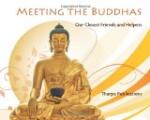They perch upon roof and gable,
On porch and fence and tree,
They flutter about the windows
And peer in curiously.
And meet the eyes of the children,
Who eagerly look out
With cheeks that bloom like roses red,
And greet them with welcoming shout.
On the joyous Christmas morning,
In front of every door
A tall pole, crowned with clustering grain,
Is set the birds before.
And which are the happiest, truly,
It would be hard to tell;
The sparrows who share in the Christmas cheer,
Or the children who love them well!
How sweet that they should remember,
With faith so full and sure,
That the children’s bounty awaited them
The whole wide country o’er!
When this pretty story was told me
By one who had helped to rear
The rustling grain for the merry birds
In Norway, many a year,
I thought that our little children
Would like to know it too,
It seems to me so beautiful,
So blessed a thing to do—
To make God’s innocent creatures see
In every child a friend,
And on our faithful kindness
So fearlessly depend.
Celia
Thaxter
THE CROW.
The poor crow has had very few friends. Like many mischievous people, he has been more severely blamed than he really deserves. He has been called an egg-stealer, a bird-eater, and a corn-thief. I am afraid that this is all true, and yet it is not fair to forget the good that he does.
In the spring, before there are many insects for him to eat, the hungry crow will sometimes do a great deal of mischief.
He troubles the farmer by pulling up the tender young corn, but a way to prevent this has been found. If the corn is dipped in soft tar, and afterwards in powdered lime to give it a white coating, the crow will not touch it. He does not like the taste of tar, and he will look elsewhere for his dinner.
Some farmers feed the crows by scattering loose grain over the surface of the cornfield, and in many cases the birds have been satisfied with what they received in this way.
Now let us see why it is for the farmer’s interest to make friends with the crow. In the early days of New England, crows were thought to be so harmful that many of them were killed. The next year the grass and the crops were greatly injured by worms which the crows would have destroyed. It has often been proved that when a large number of crows and blackbirds have been killed, there has been an increase of harmful insects.
Crows eat the cutworm, the white grub, and the weevil. They like no food so well as mice. In the spring they like to follow the plough and pick up hundreds of insects that would do more harm than the most mischievous crow.




